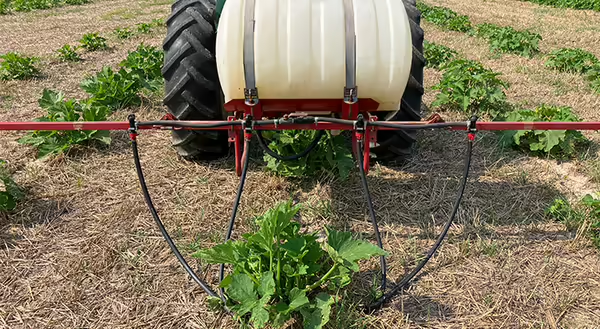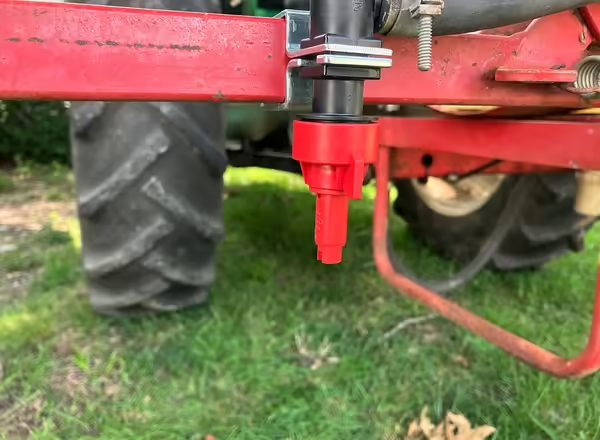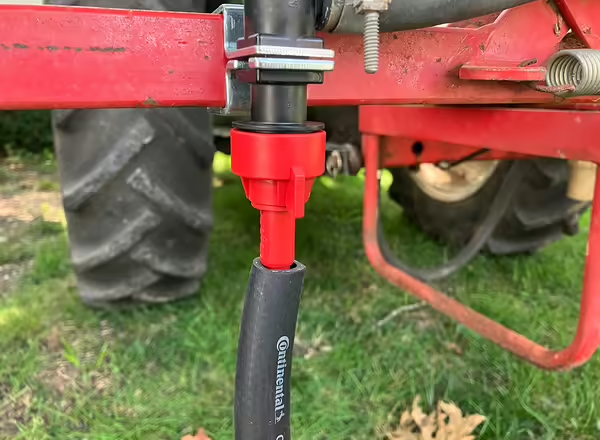
While fertigation is a great way to give our crops an extra boost, we still have many crops grown that are not irrigated and could benefit from a midseason nutrient boost. I am going to share the equipment I have put together to side dress nitrogen on pumpkins. It could also be adapted to other crops as well. Some examples could be at pre staking of tomatoes or peppers, any cucurbits before vine run, cole crops, etc.
It starts with a basic sprayer. The one I had was a simple 3-point hitch, 60 gallon sprayer. It needed new nozzle bodies and tips, so I was already going to re-plumb and upgrade it. I added nozzle bodies that had a built-in check valve to prevent dribbling and quick connect nozzle caps for easy cleaning and access. If you already have a sprayer ready to use, there is no reason to change.
Before we get any further, remember that most liquid fertilizers we might use such as urea-ammonium nitrate (UAN), ammonium thiosulfate, etc. are extremely corrosive. Ideally, you want to have all components that the liquid flows through be plastic or stainless steel. Brass can be used but is not best. Walk through all components from tank to nozzle and upgrade any fittings, elbows etc.
Application Rate
You need to start by thinking about the nutrient rate (range of rates) you want to be able to deliver per acre. Then look at products readily available and end up with the number of gallons per acre you are needing to deliver for that nutrient rate. For this part think of the standard rate you want to apply but also what the maximum rate you would need for any possible crops. My main focus was using UAN which is either 28% or 32% nitrogen by weight. Note also that many of these fertilizers are heavier than water and will not flow and pump as quickly as water. The University of Georgia Extension has a nice factsheet that goes into more detail about adjustment factors for calibrating liquid fertilizer applicators.
The Pump
The pump is the next component we need to upgrade. I utilized a high volume 12-volt bypass type electric diaphragm pump. These pumps work well for smaller sprayers and most are compatible with fertilizer materials. For electric pumps look at the max output, pressure and amperage needed to make sure everything fits your equipment and needs. Standard power take off (PTO) roller or centrifugal pumps have steel or cast iron housing and components and will corrode and not hold up. You can get PTO diaphragm pumps and some stainless steel roller pumps that can be an option for higher volumes. Sizing the pump is very important. Take that maximum rate you had in mind to apply and work backwards through calibration to get an approximate idea of the gallons per minute you will need. Ensure you get a pump that will deliver more than enough volume to apply the rate at a comfortable application speed.


The Nozzles and Delivery
I wanted to deliver fertilizer near the plant in a concentrated band. I started with nozzles. The purpose of the nozzles in this use is not so much for the pattern it sprays but as a metering device to control the fertilizer flow. I used the TeeJet Air Induction nozzles; these nozzles are nice because they are very long, which will come in handy. 1/2 inch black ag sprayer hose fits perfectly over the nozzle and I secure it with a hose clamp. With the sprayer adjusted to the correct application height based on crop growth, I cut the hose long enough it would loosely drag on the ground. I then took two hoses from each side and zip tied them together. When you do this, adjust where you put the two hoses together and where you tie them together. This can help adjust where the hoses trail and where that band will be applied. Having the two hoses together helps keep the hoses from bouncing and gives some way to direct them. This is where you could, if needed, add a piece of small PVC pipe or other semi ridged material as needed to help guide them.
This is also where you need to look back at the calibration so you can size the nozzles appropriately. I figured that if I used four “04” output nozzles per row this would get me in the product rate range I needed to be. Most nozzle manufacturers have very good charts that look at the range of nozzle sizes at various pressures and speeds. For me, I needed around 30 gallons per acre and can achieve that with the “04” nozzles at 40 psi at around 3.5 miles per hour which is a comfortable speed. The hoses start to bounce a lot more at speeds above 3.5 miles per hour.
This is the second year I have used this set up and I have been very happy. I get a very consistent band of fertilizer about 8-12 inches on either side of the row and the pumpkins respond very well to it. I am able to use the tender trailer from the local fertilizer dealer to transport material. Previously, I walked the field with a bucket and dry fertilizer. This was fine when I had an acre or so but at 5 acres and needing almost a ½ ton of dry fertilizer this got to be more work and time than I wanted to tackle efficiently. Additionally in the end of July in southern Illinois dry fertilizer is just about a liquid by the time you get it to the field already given our humidity, so it was messy to work with as well.
I’m sure many of you could improve on this design and concept. I hope it gives you some ideas of simply ways to utilize basic equipment on your farm to manage your crops better and more efficiently.
Note: This is an example of how adapt equipment, but by no means is the only way to do it. This article is meant to be an inspiration for you to customize and adapt to you own scale and equipment.